Email marketing needs to be a priority for all businesses in 2018.
It doesn’t matter what type of company you have or what industry you’re in. In fact, 89% of marketers named email as their primary method of lead generation.
If you are putting more effort into your email marketing strategy, you’ve got the right mindset.
That said, just because you’re sending lots of promotional emails doesn’t necessarily mean they are effective.
Some of your emails might be getting marked as spam.
You spent time carefully writing your content, but you didn’t get the results you had expected. Why did that happen?
As you’ll soon learn, there are several different reasons why your emails are getting marked as spam. That was my inspiration for writing this guide.
I want to help you identify what’s putting your messages in the spam folder.
Even if you’re not currently getting your content marked as spam, you can still benefit from this guide. Understanding these email principles and best practices for writing marketing content will help you avoid these mistakes in the future.
In a perfect world, your emails should go straight to the recipient’s inbox, get opened, and generate click-throughs.
But you can’t get conversions if your content is being marked as spam. Keep my recommendations in mind, and use this guide as a reference moving forward.
Understand how consumers define spam
Spam used to be pretty easy to identify.
You’d get a message saying you won a contest you didn’t enter. The subject line would have a bunch of stars and other sketchy characters.
The message would come from an unknown sender.
In your lifetime, you probably even got some spam messages with subjects featuring NSFW content. I don’t think I need to provide an example of this since I’m sure you have an idea of what I’m referring to.
Years ago, spam would even contain malicious content, e.g., attachments containing viruses or phishing scams.
But email software has improved over time, and these messages tend to go straight to the spam folder.
However, now legitimate brands are getting emails marked as spam because the consumer definition of it has changed:
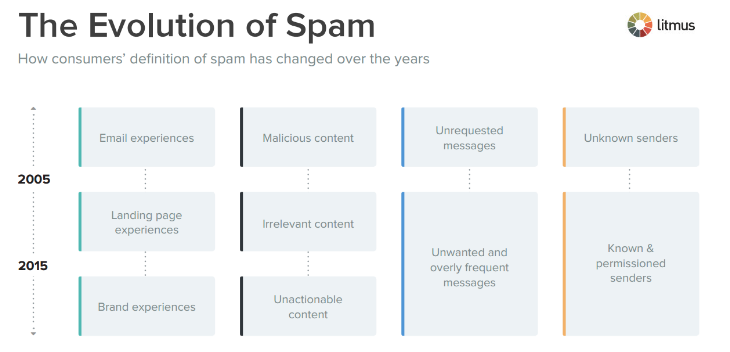
As you can see, consumers report messages as spam even if they know the sender. They’ll even flag spam from senders who have their permission to send them emails.
This is a big game changer.
Someone could willingly sign up to receive emails from your brand and still send your content to the spam folder.
Studies show 57% of people say getting too many emails from a sender or receiving irrelevant messages causes them to mark the content as spam.
What does this mean for you as a marketer?
It means that your promotional messages are susceptible to getting marked as spam. Being a reputable brand and sending messages only to your subscribers doesn’t make you immune to this.
Don’t buy subscribers
As I just said, even recipients who subscribed to receive emails from a brand are still marking messages as spam.
If you’re buying email lists and sending content to people who never signed up to receive them, there is even a greater chance you’ll be heading for the spam folder.
Furthermore, you’re putting yourself at risk of violating the CAN-SPAM Act, which is enforced by the Federal Trade Commission.
Overall, sending unsolicited emails is just a losing strategy. In addition to the legal repercussions, it’s terrible for your brand reputation.
An average person who works in an office receives 121 emails each day. They won’t waste time checking unwanted messages.
Put yourself in their shoes for a minute. If you get a promotional message from a brand you never heard of and never signed up for, are you going to buy something from them? Probably not.
You can’t expect to see results from other people who receive these unwanted messages.
Instead, you should be focusing on how to grow your email list by getting new subscribers. Include signup forms on your website.
Research shows that the most common placement for email opt-in forms is in the footer of each page.

Give this strategy a try, and watch your email list grow.
Now, you’ll be sending promotional content to people who actually want to hear from you as opposed to random email addresses you purchased.
Check spam risk before you hit send
Most email software for marketers has a built-in feature that checks for spam.
It scans your message and determines how likely it is to get sent to the spam folder.
To avoid a high spam risk, make sure you limit the use of promotional words such as:
- free
- buy
- promo
Don’t get me wrong, you can include these words in your message, but use them sparingly.
Avoid special characters and writing in all capital letters. Don’t make obscure choices, e.g., adding spaces between letters, like F R E E.
Make sure the size of your email isn’t too big either.
If you’ve got links, be sure they from reputable websites with a high domain authority.
Your messages shouldn’t be too text-heavy or image-heavy. Balance text and images.
Don’t include too many colors or text written in colors difficult to read.
Here’s an example of what the spam check feature looks like on the Constant Contact platform:
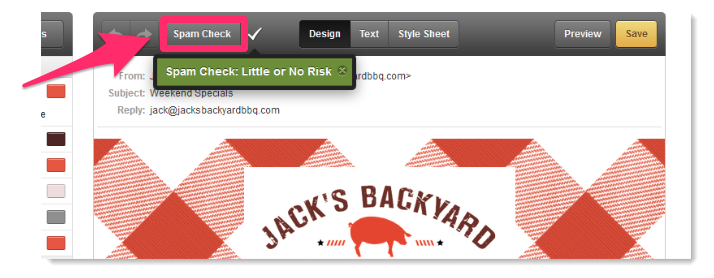
It may look a bit different on a different platform, but you’ll still be able to accomplish the same thing.
If your spam checker says you’re at a high risk of being marked as spam, you need to make some changes before you hit send.
Limit your sending frequency
As a business owner, you think about your brand 24 hours a day. I can relate to this.
You’re always coming up with new ideas to promote your company.
But your customers and email subscribers aren’t always thinking about you the same way you think about them. That’s just a reality. Can you blame them?
They have more important things on their minds, and they don’t want to hear from you that often.
Distributing promotional emails on a daily basis is not going to help your cause. You need to be selective when you send a new message.
When it comes to receiving emails, consumers report that sending emails too often is the number one most annoying action taken by marketers:
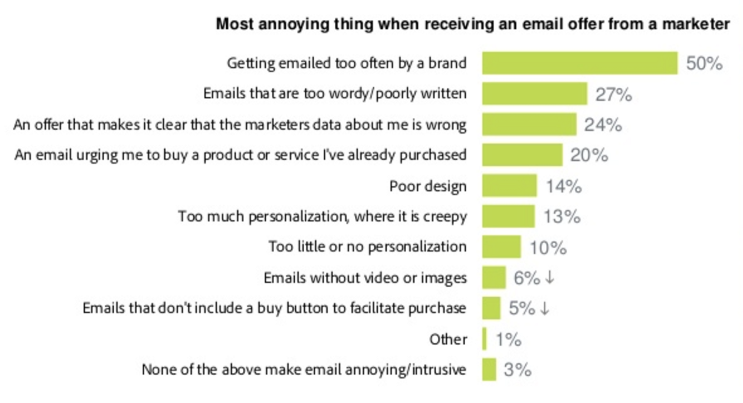
I’d recommend limiting these messages to once a week at the most.
You can even change the sending frequency based on what the subscriber prefers.
When a new customer signs up to receive your content, ask them how often they want to hear from you. You can segment this list by people who want weekly messages or just a monthly newsletter.
Giving your subscribers exactly what they’re asking for reduces your chances of getting marked as spam.
Use a clearly labeled “from” field address
Make it clear whom the email is from.
Some of you may have multiple email addresses within your domain, depending on the size of your company.
For example, if someone submits a complaint or request for help on your website, they may get a reply from a support@yourdomain.com.
But if they’re trying to make a purchase or return an item, email inquiries might be made through sales@yourdomain.com.
Don’t change the sender field too often. Try to stick with the one that works best for your promotional messages.
Avoid odd choices, such as donotreply@yourdomain.com or 372as2y9@yourdomain.com.
Make sure you create a solid reputation for these sender fields. It will build trust with your subscribers and even increase the chances that they will add the address to their contacts lists.
If they are used to receiving your marketing emails from the same sender address and one day it comes from a different one, they may think it’s spam.
Even if that message is coming from your company, it’s confusing to your subscribers.
Don’t try to trick the recipient
I see people make this mistake all the time.
In an attempt to increase email open rates, they try to be sneaky and trick their subscribers into clicking the message.
That’s a big mistake. Tricking your customers can damage your brand.
In addition to marking your message as spam, the recipient might ultimately unsubscribe from your email list. More than half of consumers say they have felt cheated or tricked into opening a promotional email:
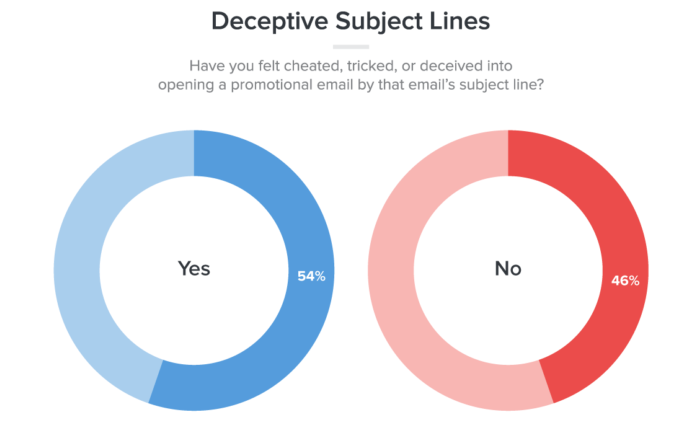
I’ll share with you some strategies that are perceived as deceptive by recipients.
Do not start your subject line with “Fwd:” or “Re:” to try to get more opens. This type of text implies you’ve already had a previous communication with the subscriber.
Discovering this was not the case will put a bad taste in their mouths.
Don’t send a message telling people they’ve won a prize if they haven’t actually won anything. Again, this is a fast way to disappoint the recipient and get your content marked as spam.
I’ve also seen some marketers conceal spam content by creating an image with text written on it.
You might fool spam filters, but you won’t fool the person who opens the email. They’ll still send you to the spam folder.
Stay relevant
You need to focus on the content of your messages.
Ask yourself these questions before you hit send: Why are you sending this email? Is this message adding value to the subscriber?
If you don’t have a clear answer to these, you should probably re-evaluate the message.
Don’t send content just to say hello or provide a friendly reminder that your company exists. Your subscribers don’t care about this.
Here’s a look at the top reasons why emails get reported as spam:
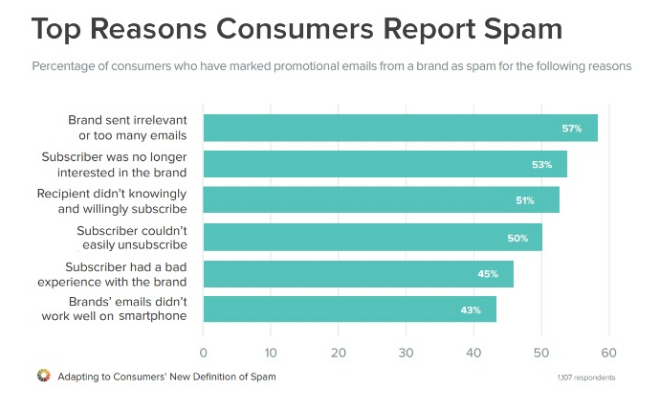
Take a look at the top reason.
Earlier I talked about how the frequency of your emails can cause you to get marked as spam. Well, there is a second part to this principle.
Your content needs to be relevant.
Even if you’re sending emails only weekly or bi-monthly, you can still get sent to the spam folder if the subscribers think the message is irrelevant.
For example, let’s say you run an ecommerce website selling home furniture. A marketing email updating your subscribers about the weather doesn’t add value to their lives. It also has nothing to do with your brand.
Make an effort to always stay on brand.
If it’s been a while since you’ve communicated with your subscribers and you feel like it’s time to send a new email, you probably can’t go wrong by sending out a discount or promotional code.
Run a flash sale, or send an exclusive personalized offer.
These types of messages are likely to get opened and lead to conversions.
Master your subject lines
A successful email marketing campaign starts with the subject line.
You could have the best promotional message in the world, but nobody will see it if they don’t open the message.
It’s in your best interest to keep your subject line as short as possible. Research shows that email subjects between 1 and 20 characters yield the highest open rates, regardless of what type of email you’re sending.
This is partially due to the fact that 55% of emails are opened on mobile devices.
If your subject line is too long, it will get cut off when it’s viewed on a cell phone. If the subscriber can’t read the full subject, it decreases the chances they’ll open the message.
Let’s put open rates aside for a minute and get back to the topic of discussion: spam.
Research shows that nearly 70% of emails get flagged as spam just based on the subject line:
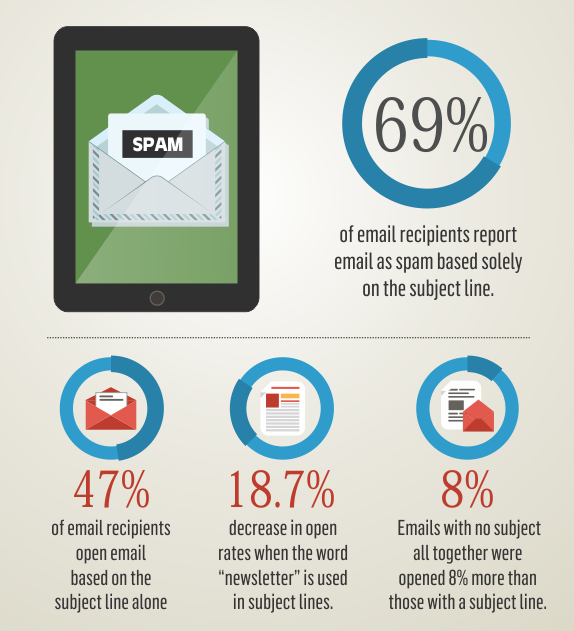
Learning how to write email subject lines will help reduce your chances of getting marked as spam.
I recommend personalizing your subject lines. Personal subjects have higher open rates and click-through rates. They also tend to increase website traffic and drive sales.
Use your subject line to create a sense of urgency. Provide an offer that won’t last forever, and make sure it’s properly conveyed in the subject.
Tell a story. Provide breaking news. Stimulate curiosity.
These are all great types of subject lines that will entice your subscribers to open your messages instead of reporting them as spam.
Conclusion
It’s great you’re focusing on your email marketing campaigns. But if your content is getting marked as spam, it’s obviously not an effective strategy.
Times have changed. Even reputable brands who have permission from recipients to send emails are getting flagged as spam.
The key is being able to identify why emails get sent to the spam folder and how you can avoid this from happening to you.
Never buy subscribers or send unsolicited emails. Instead, use your website as a tool for growing your email list.
Use tools to help check your content for spam before you hit send.
Don’t send marketing emails too often. Clearly label the sender field, and don’t change this address.
Do not deceive your subscribers by tricking them into opening a message. Always make sure the content of your emails is relevant.
Learn how to write subject lines that lead to opens and clicks as opposed to the spam folder.
Following these tips will help you avoid getting marked as spam. Ultimately, this will lead to higher conversions for your business.
How is your brand writing promotional emails without getting marked as spam?
from Quick Sprout https://ift.tt/2mdvx2Z
via IFTTT
